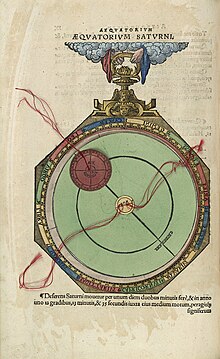Equatorium
This article may require cleanup to meet Wikipedia's quality standards. The specific problem is: tone, rmv WP:NOTHOWTO and other issues, improve sourcing. (July 2018) |

An equatorium (plural, equatoria) is an astronomical calculating instrument. It can be used for finding the positions of the Moon, Sun, and planets without arithmetic operations, using a geometrical model to represent the position of a given celestial body.
History[]
Planetary equatoria were probably made by ancient Greeks, although no findings nor descriptions have been preserved from that period. In his comment on Ptolemy's Handy Tables, 4th century mathematician Theon of Alexandria introduced some diagrams to geometrically compute the position of the planets based on Ptolemy's epicyclical theory. The first description of the construction of a solar (as opposed to planetary) equatorium is contained in Proclus's fifth-century work Hypotyposis,[1] where he gives instructions on how to construct one in wood or bronze.[2]
The earliest surviving descriptions of planetary equatoria are the Latin translations of Arab works contained in the Libros del saber de astronomia (Books of the knowledge of astronomy), a Castilian compilation of astronomical works collected under the patronage of Alfonso X of Castile in the thirteenth century: an early eleventh century text by Ibn al‐Samḥ and a 1080/1081[3] treatise by al-Zarqālī.[2]
The Theorica Planetarum (c. 1261–1264) by Campanus of Novara is the earliest extant description of the construction of an equatorium in Latin Europe.[4] Campanus' instrument resembled an astrolabe, with several interchangeable plates within a mater. The best manuscripts of Campanus' treatise contain paper and parchment equatoria with moveable parts.[2]
Variations[]

The history of the equatorium does not just end after the 11th century, but it inspired a more diverse invention called “The Albion”. The Albion is an astronomical instrument invented by Richard of Wallingford at the beginning of the 14th century.[5] It has various functional uses such as that of the equatorium for planetary and conjunction computations. It can calculate when eclipses will occur. The Albion is made up of 18 different scales which makes it extremely complex in comparison to the equatorium. The history of this instrument is still disputed to this day, as the only Albion from the past is both unnamed and unmarked.[5]
Astrolabe compared with equatorium[]
To understand where the roots of the Equatorium began, look back to what inspired it: the astrolabe. The history of the Astrolabe dates back to roughly 220 BC and was invented by Hipparchus.[6] The difference between the two instruments is that the Astrolabe measures the time and position of the sun and stars at a specific location in time. There are also specialized astrolabes for land and for boats. The Astrolabe works by adjusting the moveable components (labels) to a specific date and time.[7] Afterward, line up the astrolabe with the horizon by holding it up and setting one end of the label to where one end is at eye level and the opposite end is pointed towards whichever celestial structure you want to view.[7] In contrast, the equatorium is a rarer astronomical instrument. It is used to calculate the past or future positions of the planets and celestial bodies according to the planetary theory of Ptolemy. What is similar about these tools is that they are both calculating devices that simplify and efficiently make geometrical calculations.
Uses[]
The equatorium can further be specialized depending on the epicycle. There are three possible epicycles that can be adjusted to serve for planetary positions in three groups: the moon, the stars, and the sun. The sun was considered a planet in the Ptolemaic system, hence why the equatorium could be used to determine its position.[8] Through the use of Ptolemy's model, astronomers were able to make a single instrument with various capabilities that catered to the belief that the solar system had the earth at the center. In fact, specialized equatoriums had astrological aspects of medicine, as the orientation of planets gave insight to zodiac signs which helped some doctors cater medical treatments to patients.
At least 15 minutes was needed to calculate the planetary position with the use of a table for each celestial body.[9] A horoscope of that era would have required the positions of seven astronomical objects, requiring nearly two hours of manual calculation time.
See also[]
| Wikimedia Commons has media related to Equatorium. |
- Antikythera mechanism
- Armillary sphere
- Astrarium
- Astrolabe
- Astronomical clock
- Orrery
- Planetarium
- Torquetum
- The equatorie of the planetis
References[]
- ^ Proclus (1909). Hypotyposis Astronomicarum Positionum. Bibliotheca scriptorum Graecorum et Romanorum Teubneriana. Karl Manitius (ed.). Leipzig: Teubner.
- ^ a b c Evans, James (1998). The History and Practice of Ancient Astronomy. Oxford & New York: Oxford University Press. p. 404. ISBN 978-0-19-509539-5.
- ^ "Zarqali". islamsci.mcgill.ca. Retrieved 2018-05-09.
- ^ Toomer, G. J. (1971). "Campanus of Novara". In Gillispie, Charles Coulston (ed.). Dictionary of scientific biography. III. New York: Scribner. pp. 23–29. ISBN 978-0-684-10114-9.
- ^ a b Truffa, Giancarlo. "The Albion of Rome. A unique example of Medieval Equatorium". Cite journal requires
|journal=(help) - ^ "Third Solution: The Equant Point - SliderBase". www.sliderbase.com. Retrieved 2018-05-09.
- ^ a b "the definition of astrolabe". Dictionary.com. Retrieved 2018-05-09.
- ^ Colledge, Eric (1955). "THE EQUATORIUM OF THE PLANETS". Blackfriars. 36 (424–5): 276–284. JSTOR 43816789.
- ^ Fosmire, Michael (2014). "Richard of Wallingford". Biographical Encyclopedia of Astronomers. Springer, New York, NY. pp. 1831–1832. doi:10.1007/978-1-4419-9917-7_1167. ISBN 978-1-4419-9916-0.
Further reading[]
- Astronomical instruments
- History of astrology
- Historical scientific instruments
- Analog computers
- Arab inventions
- Mechanical calculators